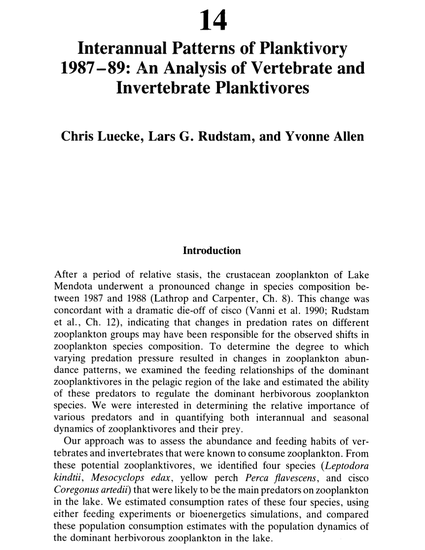
Contribution to Book
Interannual patterns of planktivory 1987- 1989: an analysis ofvertebrate and invertebrate planktivores
Food Web Management: A Case Study of Lake Mendota
(1992)
Abstract
After a period of relative stasis, the crustacean zooplankton of Lake Mendota underwent a pronounced change in species composition between 1987 and 1988 (Lathrop and Carpenter, Ch. 9). This change was concordant with a dramatic die-off of cisco (Vanni et al. 1990; Rudstam et al., Ch. 12), indicating that changes in predation rates on different zooplankton groups may have been responsible for the observed shifts in zooplankton species composition. To determine the degree to which varying predation pressure resulted in changes in zooplankton abundance patterns, we examined the feeding relationships of the dominant zooplanktivores in the pelagic region of the lake and estimated the ability of these predators to regulate the dominant herbivorous zooplankton species. We were interested in determining the relative importance of various predators and in quantifying both interannual and seasonal dynamics of zooplanktivores and their prey.
Keywords
- patterns,
- planktivory,
- planktivores
Disciplines
Publication Date
January 1, 1992
Editor
J.F. Kitchell
Publisher
Springer
Citation Information
Luecke, C., L.G. Rudstam, and Y. Allen. 1992. Interannual patterns of planktivory 1987- 1989: an analysis of
vertebrate and invertebrate planktivores: 221-242 In J.F. Kitchell, J.F. (ed.). Food Web Management: A
Case Study of Lake Mendota. Springer.
